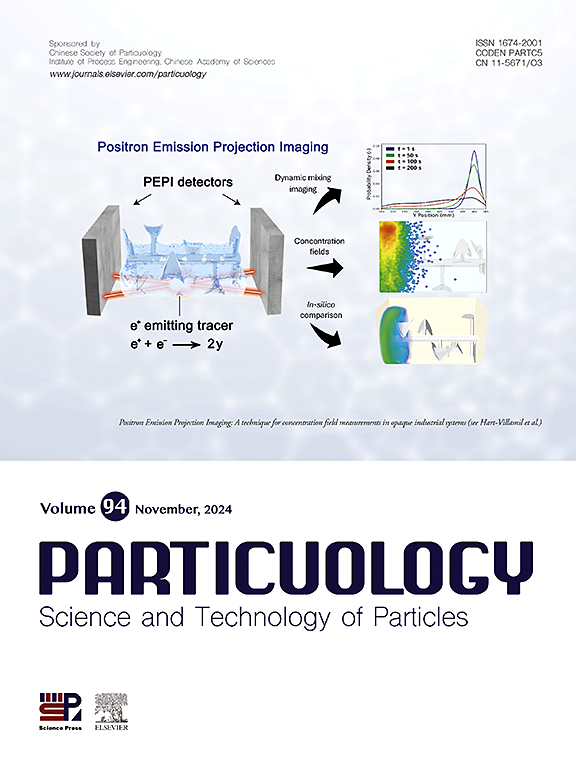A meso-scale flow model of gas-liquid-solid mini-fluidized beds with improved macro-scale interaction of wall effects
IF 4.1
2区 材料科学
Q2 ENGINEERING, CHEMICAL
引用次数: 0
Abstract
Gas-liquid-solid mini-fluidized beds known for high efficiency with controllable mass and heat transfer characteristics, have good application prospects in fields such as multiphase reaction process enhancement and intrinsic kinetic detection. For three-phase mini-flow systems, the bed wall has a significant impact on spatiotemporal distribution of multi-phase flow structure, which influence the motion state of dispersed phase, make predicted phase holdup and residence time deviate from experimental values. However, current research on the quantitative impact of bed walls on flow structures is still limited, which hinders the optimization design and industrial application of such reactors. In this work, a meso-scale flow model of gas-liquid-solid mini-fluidized beds considering macro-scale effects between bed wall and flow is developed based on the principle of meso-scale science and introducing semi-theoretical formulas that take the effects of bed walls on particles and bubbles into account. The calculated values of this model are in good agreement with experimental data, where prediction of phase holdup fits well with experimental results, the deviation of bubble size and terminal velocity are within 10%. Compared to existing models, this model demonstrates a higher level of accuracy in predicting the flow patterns of mini-fluidized beds, particularly those with pronounced wall effect. This research has laid a foundation for the design, scale-up and industrial application of mini-fluidized bed reactors.

改进壁面效应宏观尺度相互作用的气液固微型流化床中尺度流动模型
气-液-固微型流化床以其效率高、传质传热特性可控等优点,在多相反应过程强化、本态动力学检测等领域具有良好的应用前景。对于三相微流系统,床壁对多相流结构的时空分布有显著影响,影响分散相的运动状态,使预测相含率和停留时间偏离实验值。然而,目前关于床壁对流动结构的定量影响的研究仍然有限,这阻碍了此类反应器的优化设计和工业应用。本文基于中观尺度科学原理,引入考虑床壁对颗粒和气泡影响的半理论公式,建立了考虑床壁与流动之间宏观效应的气-液-固微型流化床中观尺度流动模型。该模型计算值与实验数据吻合较好,相含率预测值与实验结果吻合较好,气泡尺寸和终端速度的偏差在10%以内。与现有模型相比,该模型在预测微流化床流态,特别是具有明显壁面效应的微流化床流态方面具有更高的精度。该研究为微型流化床反应器的设计、规模化和工业应用奠定了基础。
本文章由计算机程序翻译,如有差异,请以英文原文为准。
求助全文
约1分钟内获得全文
求助全文
来源期刊

Particuology
工程技术-材料科学:综合
CiteScore
6.70
自引率
2.90%
发文量
1730
审稿时长
32 days
期刊介绍:
The word ‘particuology’ was coined to parallel the discipline for the science and technology of particles.
Particuology is an interdisciplinary journal that publishes frontier research articles and critical reviews on the discovery, formulation and engineering of particulate materials, processes and systems. It especially welcomes contributions utilising advanced theoretical, modelling and measurement methods to enable the discovery and creation of new particulate materials, and the manufacturing of functional particulate-based products, such as sensors.
Papers are handled by Thematic Editors who oversee contributions from specific subject fields. These fields are classified into: Particle Synthesis and Modification; Particle Characterization and Measurement; Granular Systems and Bulk Solids Technology; Fluidization and Particle-Fluid Systems; Aerosols; and Applications of Particle Technology.
Key topics concerning the creation and processing of particulates include:
-Modelling and simulation of particle formation, collective behaviour of particles and systems for particle production over a broad spectrum of length scales
-Mining of experimental data for particle synthesis and surface properties to facilitate the creation of new materials and processes
-Particle design and preparation including controlled response and sensing functionalities in formation, delivery systems and biological systems, etc.
-Experimental and computational methods for visualization and analysis of particulate system.
These topics are broadly relevant to the production of materials, pharmaceuticals and food, and to the conversion of energy resources to fuels and protection of the environment.
 求助内容:
求助内容: 应助结果提醒方式:
应助结果提醒方式:


